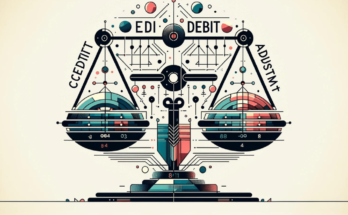Introduction to EDI Payments in Retail Banking
This is all the more important amid our fast-changing digital economy. EDI has brought about a revolution in banking operational processes, making bank products and services more customer-focused. These changes are not only designed to shorten the time required for transactions, they also increase banking operations’ accuracy and dependability. As digital transformation becomes an ever-greater force in many industries, EDI payments become a key means of transforming the banking industry to restructure and be reformed according to people’s new needs and expectations as consumers or businesses.

How EDI Works:
EDI operates around the principle of standardized data transfer. When a company wants to send information to another, the data is formatted per EDI payments standards. This set format means that the data is understandable to and usuable by he receiving computer system.Read this…Difference in EDI Payments/ EDI & ACH
How EDI Works: Making Data Chat Easily
The Universal Translator of DataThink of EDI payments as a universal data translator. EDI is the tool a company uses when it needs to transfer important info someone else. That complex data is transformed into a special standard language understandable to any computer system, no matter what kind of software it’s running. Its like a message written in secret code that only the right person can unravel.
EDI’s Financial Odyssey:
From Trucks to Transactions Back in the hedonistic ’60s, originally designed for use in logistics and transportation. The story of EDI began here. However, the finance world found its value. Businesses sought a better way to deal with the mire of paperwork: invoices and payments. Thus EDI payments is in banking, and it has changed the game. Transactions speeded up, errors went down and record keeping became much easier. EDI became a big fish in the world of digital finance as technology developed.
EDI in Retail Banking A Digital Revolution:
Stepping into the Digital Future
For retail banking, adding EDI was like going in a time machine and zooming into the future. Banks abandoned the old fashioned, manual way of doing things and began using EDI to get their work done. It wasn’t simply about speeding things up, but also keeping pace with our fast-paced digital world. Making Customers Smile.With EDI, banks could give customers what they wanted faster and with fewer mix-ups. It meant less time hanging around waiting for transactions to clear and more time being able to bank smoothly, without hassles.
 The various faces of EDI in Banking A jack-of-all-trades EDI payments in retail banking. It handles all sorts of things.Read me….EDI Payments Auditing and Reporting
The various faces of EDI in Banking A jack-of-all-trades EDI payments in retail banking. It handles all sorts of things.Read me….EDI Payments Auditing and Reporting
- Moving Money: EDI smoothes the path for transferring funds between accounts, whether they’re in the same bank or not.
- Paying Bills Made Easy: It also helps customers pay their bills online, to make sure they are both on time and right.
Benefits of EDI in Retail Banking
- Making Banking Smooth with EDI
EDI: The Banking Life-SaverThink of EDI as the magic wand in banking. Not only does it make life easier for us consumers; it’s also a big help to the banks themselves. EDI makes a slick, efficient way for banks to handle our money matters. It’s like having the most efficient assistant imaginable who never tires and always gets it right.
- Banking Goes Digital: The Latest Buzz:Surfing the Digital Tsunami Recently there’s been a tidal wave in banking, with EDI payments leading the charge. But thanks to the seduction of digital efficiency, more banks are jumping on board with EDI payments every day.
- All of us want to get our banking on-line.And guess what? We’re all enjoying the digital form of banking. It’s becoming quite evident to many that clicking buttons is a lot more fun than waiting in line. It’s not just a fashion. Its digitalization is the future, and EDI payments is coming in first.
- EDI:The Speedy Gonzales of BankingMaking: Transactions Zoom In banking, EDI payments is like putting your business on the express train. There’s no longer the need to wait around for days; now, things that used to take years happen in just a few hours–or minutes!
- Streamlined and Smooth:With EDI payments, banking is the smoothest and slickest there ever was. This avoids many steps in the transaction process, so banks don’t have to do things manually. This makes everything run more smoothly and faster, as if running on automatic pilot.
- Reducing Errors and Saving Money:Minimizing Human ErrorEDI payments automates data exchanges, thus reducing the risk of human error in banking transactions. Such accuracy is important for reliable financial operations.For more Detai….EDI BLOG
- Cutting Down Operational Costs:Correction of mistakes and streamlining paper files are cost-cutting measures for banks. For both banks and their customers, this cost efficiency is a big win.
- Enhanced Security and Compliance:Safeguarding Transaction Data EDI systems are built with tough security standards. In transactions, they protect sensitive financial information. This gives banks and their customers peace of mind.
- Meeting Regulatory Standards:Such is the importance of compliance in banking that EDI can help banks fulfill regulatory and standard requirements within a legal framework.
- Improved Customer Satisfaction:Elevating Customer ExperienceWith EDI payments, banking services are faster and more accurate. It greatly enhances the entire customer experience because clients get faster and more dependable services.
- Building Customer Trust:High-quality transactions build customer confidence in their banks. This trust is essential to building long-term customer relations.

Challenges and considerations in retail banking EDI
Integration with Existing Banking SystemsSeamless Merging of Technologies
Seamless Integration into Existing Banking Systems One of the major barriers to introducing EDI in retail banking is this. Banks already have established systems and procedures, so EDI paymentsneeds to be implemented in a planned fashion with as little interference or change as possible.
- Tailored Solutions and Training:EDI solutions must be customized to meet each individual bank’s unique infrastructure requirements. Besides that, training of staff is important so as to make them comfortable and efficient in using the new system.
- Ensuring Data Security and Privacy:Protecting Sensitive InformationSince EDI payments involves the transmission of enormous quantities of sensitive financial data, security and privacy have to be first-rate. This is a challenge of implementing strong encryption and data-handling processes to protect against hacking or intrusion.
- Building Customer Trust:The bank’s ability to protect the financial information of its clients is a prerequisite for preserving and improving customer trust. Banks must not only safeguard the data but they also need to effectively communicate these measures to their customers.
- Understanding changing standards and regulations:Navigating Regulatory LandscapesIn EDI or other related fields, the financial sector is very heavily regulated, and keeping up to date with changing standards and regulations has been a test for banks. It means being well-informed and flexible to ensure compliance at all times.Detail aboute edi….EDI Payments Reducing Costs and Increasing Efficiency
- Continuous Adaptation:As new regulations and standards come down, banks will have to keep their EDI systems continually up-to-date. This means being flexible, and constantly learning and developing oneself in the digital finance field.
The Future of EDI Payments in Retail Banking
Predictions about Technological AdvancementsInnovating for the FutureIn the future, EDI payments in retail banking is likely to see drastic changes. EDI systems, however intelligent they are today, will probably become even smarter as their transaction processing and data analysis capabilities draw upon such technologies as artificial intelligence (AI) or machine learning.

- 01.Smarter, Faster Banking
These developments are expected to further speed and streamline banking operations. Only with more intelligent systems can banks process very large volumes of transactions accurately and quickly, to meet people’s increasing need for instant financial services.
- 02.How It May Shape Customer Experiences
Elevating Convenience and Accessibility With the development of EDI payments technology, customer experiences in retail banking are about to enter a new era with even greater levels of convenience and personalization. With such an EDI system in the future, banks could provide more personalized banking services tailored to customers ‘actual needs.
- 03.Transforming Customer Interactions:
Changes in EDI may lead to platforms for banking business that are more interactive and easy-to-use, making financial administration easier and more interesting.
- 04.Future Prospects:
Integration with New Technologies such as BlockchainGetting involved with the Blockchain for added security.EDI payments combined with such emerging technologies as blockchain offer great promise. On the one hand, blockchain’s built-in security and transparency characteristics have great potential to significantly improve EDI payments transactions ‘security.

Revolutionizing Financial Transactions
Financial transactions in retail banking could be transformed with the combination of EDI and blockchain technology. With this integration, unprecedented levels of security and efficiency as well as trust in banking operations will be realized; a new standard for the financial industry is about to take shape. get info…Types of EDI Payments
Conclusion:
In retail banking, EDI payments (Electronic Data Interchange) has revolutionized the entire transaction process. It is faster, more accurate and less error-prone than before. Its growing accuracy is impossible to exaggerate. It brings banking practice into step with the digital needs of a new era. In addition to streamlining procedures, EDI payments also enhances customer satisfaction by improving the quality of service. into the future and banking remains committed to innovation, always keeping abreast of change. With this resolve to innovate, retail banking is not only strong and stable but also customer-centered. It faces the future with confidence in what it will bring.




